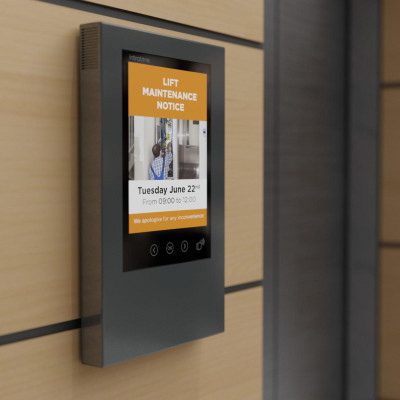Asbestos Exposure: Should You Choose a Wired or Wireless Access Control Solution?
Many factors require consideration when deciding the best access control security solution for multi-dwelling buildings.

For example, should you choose a wired or wireless solution? One such consideration when choosing between wired or wireless is the presence of asbestos and potential exposure.
Asbestos may be thought of as something from the past, but it is still part of the structure of many buildings; asbestos was banned in 1999; however, according to research, around 1.3 million tradespeople are still at risk from coming into contact with this mineral; worryingly, the HSE records that about 5000 deaths are caused every year by asbestos exposure. Intratone looks at what asbestos is and how to protect your electricians and customers from encountering it by fitting a wireless rather than wired access control solution.
What is asbestos, and why is it so harmful to health?
Asbestos was an ideal insulation material and a fire retardant, so it was commonly used in buildings worldwide. The asbestos used in building materials consists of six naturally occurring silicate-based minerals, collectively known as asbestos. The minerals that makeup asbestos are found across the world as deposits in rocks, but large-scale mining of asbestos began in the 1870s in Quebec, Canada. Asbestos continues to be mined today in countries such as Russia, Kazakhstan, and China, but most countries have banned the substance because of its profound effect on health.
Asbestos is a fibrous mineral made up of long, thin fibres; it is exposure to these fibres that cause health problems. The health issues caused by asbestos typically centre on the lungs. Asbestos fibres are light, and when the mineral is moved or disturbed, for example, during building work, these fibres are released into the air. Anyone working or living near the exposed asbestos is at risk of breathing these fibres into their lungs. The result of asbestos inhalation is lung cancer, asbestosis, and mesothelioma. The latest findings have found that asbestos causes around 2,500 lung cancer deaths yearly. Mesothelioma has symptoms including shortness of breath and chest pain, which can cause serious long-term health issues, including cancer. Asbestos is the most common cause of mesothelioma, and electricians and others working in construction are known to be at risk. With heavy, prolonged exposure to asbestos, 2% to 10% of tradespeople develop pleural mesothelioma.
Who is most at risk from asbestos?
Asbestos was used widely in construction until it was banned in the UK in 1999. While new buildings cannot use asbestos, buildings built around the time of or before the ban may still have asbestos in situ. Tower blocks and multi-occupancy buildings often have asbestos across the structure, including in wall panels, ventilation ducts, electric cables, fuse boxes, and for the insulation of electrical equipment. Anyone who works in an environment with repeated and prolonged exposure to asbestos is at risk from the mineral’s fibres. Those with the most significant risk are most likely to:
- Work on buildings built before the year 2000.
- Be involved in projects not assessed for asbestos and no precautions taken.
- Work in situations where they become regularly exposed to asbestos.
Typical tasks that lead to asbestos exposure include:
- Drilling through wallboards to install or reroute wiring.
- Cutting into dry walls.
- Removing or cutting into Artex-covered walls and ceilings.
Asbestos is often found in the following materials:
- Electric wiring insulation
- Cement siding
- Decorative plaster
- Electrical panel and partitions
- Electrical ducts
- Cement wallboards & cement siding
Electricians are often exposed to asbestos because of the nature of their work: an HSE report from 2022 recorded mortality rates for asbestosis and related diseases: the report found that there were 2,500 deaths from asbestosis and mesothelioma in 2020, mostly work-related. The report does say this:
“…the study showed that two-thirds of all British men and one quarter of women had worked in jobs involving potential asbestos exposure at some time in their lives.”
Legislation and management of asbestos in commercial buildings
Anyone managing commercial properties, including housing, must legally manage asbestos in the building. Asbestos exposure is a serious concern. This legal duty is extended to cover workers and tenants and includes potential exposure risks in common areas such as halls, stairwells, lift shafts, etc.
The UK’s HSE sets out the duty of care required by any entity that is covered by the “Control of Asbestos Regulations 2012,” these duties include:
- Find out if any materials in the building contain asbestos.
- Keep up-to-date records of the asbestos-containing materials’ location and condition.
- Carry out risk assessments of anyone possibly exposed to the materials.
- Have a plan of action in managing these materials.
- Review and monitor the plan and the arrangements to act on it regularly.
- Provide details on the materials’ location and condition to anyone liable to work on or disturb them.
Asbestos and the wired vs wireless access control debate

The costs associated with asbestos are huge, and not just to health. Anyone working in an area that has the potential for asbestos exposure should be protected by UK legislation. A 2015 update to the 2012 asbestos regulations states that “all workers/self-employed doing notifiable non-licensed work with asbestos must be under health surveillance by a Doctor.”
Electricians who fit access control systems are at risk when exposed to and disturbed asbestos. When fitting a wired solution, the electrician must drill and often saw into panels, which may be lined with asbestos. Also, asbestos is often incorporated into Artex, and other types of decorative plaster, and any removal or disturbance of Artex will release asbestos fibres. The disturbance of asbestos releases the dangerous fibres that cause mesothelioma, cancer, and other health issues. In addition, any disturbed or removed asbestos from a site must be disposed of correctly, per the UK HSE guidelines.
If an electrician or other person is accidentally exposed to asbestos, it is reportable under RIDDOR (The Reporting of Injuries, Diseases and Dangerous Occurrences Regulations 2013).
Removing asbestos altogether to prevent potential exposure to electricians and others is costly. Only specialist and licensed firms can remove asbestos, and the costs include surveys and removal – the costs can run into thousands of pounds and impact day-to-day work with residents likely needing to be rehoused during asbestos removal.
Even without removal costs, ensuring that your risk assessments and management of the asbestos are in place has many hidden costs. Asbestos exposure, however, is a real and present danger to electricians, who often must actively disturb any asbestos they come across.
Of course, a wireless access control system does not have this risk of asbestos exposure. Wireless systems are easy to fit without drilling or sawing into dangerous materials. Intratone’s wireless access control system provides control for multi-dwelling buildings using a wireless intercom and door access control equipment. Intratone’s wireless system is easy to install, has no handsets, and has no complex wiring.
Installing access control systems for multi-dwelling properties is amplified by the asbestos management required for health and safety compliance. However, a wireless system is not only cost-effective, but wireless systems mean that electricians and customers are safe from asbestos exposure.





